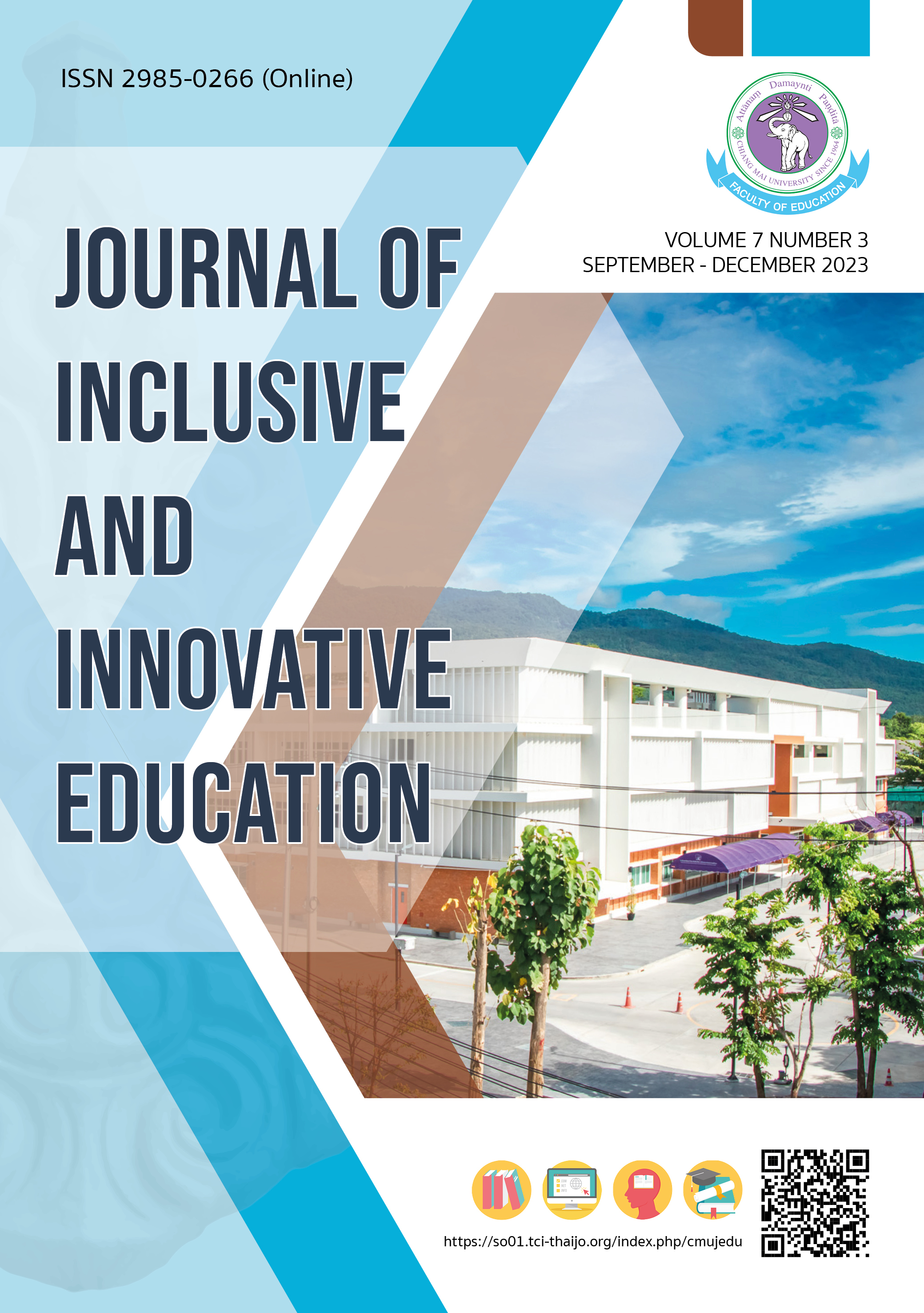การสร้างแบบคัดกรองการระรานทางไซเบอร์ของนักเรียนระดับชั้นมัธยมศึกษาตอนต้น
Main Article Content
บทคัดย่อ
การระรานทางไซเบอร์เป็นสิ่งสำคัญที่โรงเรียนควรให้ความสนใจเพราะสามารถส่งผลกระทบวงกว้างในโรงเรียนได้อย่างรวดเร็ว ผู้วิจัยจึงมีความสนใจที่จะพัฒนาแบบคัดกรองการระรานทางไซเบอร์เพื่อจำแนกนักเรียนออกเป็น 3 กลุ่ม ได้แก่ กลุ่มผู้ระราน กลุ่มผู้ถูกระราน และกลุ่มผู้เห็นเหตุการณ์การระราน เพื่อนำผลการคัดกรองที่ได้ไปใช้ในการดูแลป้องกันนักเรียนจากการระรานทางไซเบอร์ได้อย่างมีประสิทธิภาพ การวิจัยในครั้งนี้มีวัตถุประสงค์เพื่อสร้างแบบคัดกรองการระรานทางไซเบอร์ของนักเรียนระดับชั้นมัธยมศึกษาตอนต้น และเพื่อหาค่าเกณฑ์ปกติของแบบคัดกรองการระรานทางไซเบอร์ของนักเรียนระดับชั้นมัธยมศึกษาตอนต้น กลุ่มตัวอย่างที่ใช้ในการสร้างแบบคัดกรองการระรานทางไซเบอร์ของเป็นนักเรียนที่กำลังศึกษาอยู่ในระดับชั้นมัธยมศึกษาปีที่ 1-3 ภาคเรียนที่ 1 ปีการศึกษา 2566 ในโรงเรียนสังกัดสำนักงานคณะกรรมการการศึกษาขั้นพื้นฐาน 4 ภูมิภาค ได้แก่ ภาคกลาง ภาคเหนือ ภาคตะวันออกเฉียงเหนือ และภาคใต้ รวมผู้ให้ข้อมูลทั้งสิ้น 2,126 คน โดยใช้การสุ่มแบบหลายขั้นตอน (Multistage Random Sampling) เครื่องมือที่ใช้ในการวิจัย ได้แก่ แบบคัดกรองการระรานทางไซเบอร์ของนักเรียนระดับชั้นมัธยมศึกษาตอนต้น จำนวน 60 ข้อ วิเคราะห์ข้อมูลโดยการหาค่าความเชื่อมั่น ค่าอำนาจจำแนก และเกณฑ์ปกติ ผลการวิจัยพบว่า แบบคัดกรองการระรานทางไซเบอร์ของนักเรียนระดับชั้นมัธยมศึกษาตอนต้น มีค่าความเชื่อมั่น ทั้งฉบับเท่ากับ 0.95 โดยจำแนกเป็นแบบคัดกรองการระรานทางไซเบอร์ จำนวน 20 ข้อ มีค่าความเชื่อมั่นเท่ากับ 0.81 มีค่าอำนาจจำแนกรายข้ออยู่ระหว่าง 0.29 – 0.53 เกณฑ์ปกติของแบบคัดกรองมีคะแนนอยู่ในช่วง 20 ถึง 55 ตำแหน่งเปอร์เซนไทล์ อยู่ในช่วง 50.52 ถึง 100.00 ค่าคะแนนทีปกติอยู่ในช่วง T 48.62 ถึง T 70.12 แบบคัดกรองการถูกระรานทางไซเบอร์ จำนวน 20 ข้อ มีค่าความเชื่อมั่นเท่ากับ 0.90 มีค่าอำนาจจำแนกรายข้ออยู่ระหว่าง 0.44 – 0.65 เกณฑ์ปกติของแบบคัดกรอง มีคะแนนอยู่ในช่วง 20 ถึง 64 ตำแหน่งเปอร์เซนไทล์อยู่ในช่วง 67.17 ถึง 100.00 ค่าคะแนนทีปกติอยู่ในช่วง T 49.05 ถึง T 74.40 และแบบคัดกรองการเห็นเหตุการณ์การระรานทางไซเบอร์ มีค่าความเชื่อมั่นเท่ากับ 0.97 มีค่าอำนาจจำแนกอยู่ระหว่าง 0.72 – 0.85 เกณฑ์ปกติของแบบคัดกรองมีคะแนนอยู่ในช่วง 20 ถึง 80 ตำแหน่งเปอร์เซนไทล์อยู่ในช่วง 47.13 ถึง 100.00 ค่าคะแนนทีปกติอยู่ในช่วง T 49.50 ถึง T 52.95 เป็นไปตามเกณฑ์มาตรฐานที่กำหนด
Article Details

อนุญาตภายใต้เงื่อนไข Creative Commons Attribution-NonCommercial-NoDerivatives 4.0 International License.
หากผู้เสนอบทความมีความจำเป็นเร่งด่วนในการตีพิมพ์โปรดส่งลงตีพิมพ์ในวารสารฉบับอื่นแทน โดยกองบรรณาธิการจะไม่รับบทความหากผู้เสนอบทความไม่ปฏิบัติตามเงื่อนไขและขั้นตอนที่กำหนดอย่างเคร่งครัด ข้อมูลของเนื้อหาในบทความถือเป็นลิขสิทธิ์ของ Journal of Inclusive and Innovative Education คณะศึกษาศาสตร์ มหาวิทยาลัยเชียงใหม่
เอกสารอ้างอิง
Archapeth, N. (2017). Cyberbullying, The violence should be resolved and Problem Management Innovation Cyberbullying: Aggressive Misbehavior and Innovation for Solution. Academic Journal of Social Communication Innovation, 5(1), 100-106. [in Thai]
Bektaş, M. (2021). The Effects of Self-Efficacy and Locus of Control on Cyberbully/Victim Status in Adolescents. Journal of Pediatric Nursing, 61, E15-E21.
Boonmongkol, P., Aiamsilp, R., Tohphananan, S., Ojanen, T., Samakkhikarom, R., Samoh, R., and Phayakkhakom, A. (2012). Gender Identity, Gender Roles, and Cyberbullying Among Thai Adolescent Girls. in The Social Science and Health Academic Conference, Mahidol University, Bangkok.
Chadwick, S. (2014). Impacts of Cyberbullying, Building Social and Emotional Resilience in Schools. New York: Springer Education.
Charoenwanich, S. (2017). Cyber Bullying: Impacts and Preventions in Adolescents. Journal of Science and Technology, 25(4), 639-648. [in Thai]
Department of Mental Health. (2002). Mental health screening form. Nonthaburi: Department of Mental Health.
Duangphet, B. (2016). Online threats to higher education students in Chiang Mai Province. Retrieved from http://mdc.library.mju.ac.th/thesis/2561/baramet_doungpet/fulltext.pdf. [in Thai]
Internet Foundation for the Development of Thailand. (2020). The Survey of Thai Children and Cyber threats 2020. Bangkok: XL Imaging Company Limited.
K@POOK. (2018). Cyberbullying (The persecution via online channel can easily harm internet users!. Retrieved from https://health.kapook.com/view150050.html.
Lhaothong, N. (2018). Creating educational research tools. (2nd ed). Bangkok: Chulalongkorn University Press.
Lerdruttamrongkul, W. (2021). Cyberbullying of Junior high school : Bullying, Problem-Solving, and Risky Behaviors" Cyberbullying among Secondary School Students: Prevalence, Problem-solving and Risk Behaviors. Academic Journal and Research of Northeastern Regional University, 11(1), 275-289. [in Thai]
Li, Q. (2007). Bullying in the new playground: Research into cyberbullying and cyber victimisation. Australasian Society for Computers in Learning in Tertiary Education, 23(4), 44650.
Nasywa, N., Tentama, F., and Mujidin, M. (2020). Testing the Validity and Reliability of the Cyber Bullying
Scale. American Research Journal of Humanities Social Science (ARJHSS), 3(6), 132-142.
Phophrueksanan, N. (2008). Research methods. Bangkok: S. Asia Press (1989) Company Limited. [in Thai]
Praratkul, C. (2009). Measurement techniques. Bangkok: Srinakharinwirot University. [in Thai]
Raksakiattisak, S. (1996). Statistical data analysis with SPSS. Bangkok: Srinakharinwirot University. [in Thai]
Saiyot, L., and Saiyot A. (2000). Learning measurement techniques. Bangkok: Children's Club. [in Thai]
Sittichai, R. (2019). Teenager’s Cyberbullying Behavior. Bangkok: Chulalongkorn University Publisher.
Sittichai, R., and Tutkua, T. (2017). Cyberbullying behavior of youth in three southern border provinces. Journal of Academic Resources Prince of Songkla University, 28(1), 86-99. [in Thai]
Srisawat, S., Langka, W., Boriboon, K., and Saenubul, K. (2018). A Development of Bullying Prevention in School Model. Veridian E-Jourmal,Silpakorn University, 11(1), 3653-3667. [in Thai]
Surat, P. (2018). Causes and consequences related to cyberbullying: A case study of Thai youth who were bullied. Academic journal Suvarnabhumi Institute of Technology, 260-273. [in Thai]
Wanichbancha, K. (2011). Statistics for research. (6th ed). Bangkok: Thammasan Company Limited.
Weber, N. L., and Pelfrey, J. (2014). Cyberbullying Causes, Consequences, and Coping Strategies. New York : LFB Scholarly Publishing LLC.


